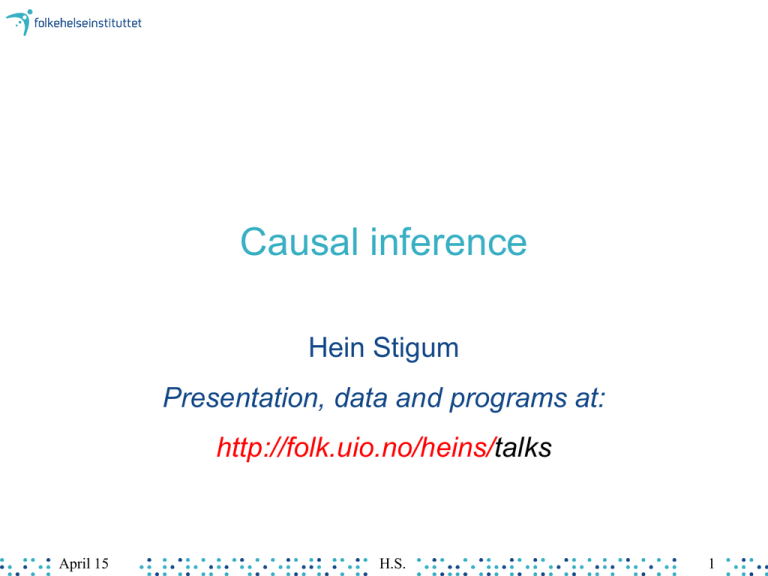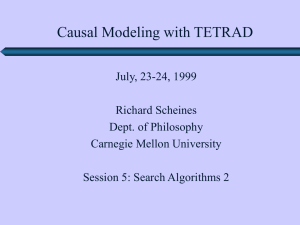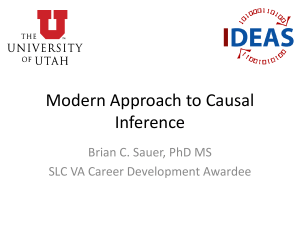
Causal inference
Hein Stigum
Presentation, data and programs at:
http://folk.uio.no/heins/talks
April 15
H.S.
1
Contents
• Background
– Error
– Bias
• Define causal effect
– Individual
– Average
• Identify causal effect
– Exchangeability
– Positivity
– Consistency
April 15
H.S.
2
Background
April 15
H.S.
3
Error
Random error
Systematic error
• Source: sampling
•
Source: design
• Expressed as:
•
Expressed as bias:
– p-values
– Confidence intervals
(precision)
1. Selection bias
2. Information bias
3. Confounding
• Affect
•
– All measures
Affect:
– Frequency measure
– Association measure
Causality field: Strong focus on bias at the expense of precision
Apr-15
H.S.
4
Precision and Bias
Precision
Bias
True
value
Estimate
Precision
Bias
Causal
effect
Apr-15
Association
H.S.
Bias:
association causal effect
Objective:
find effects
5
Define Causal Effects
April 15
H.S.
6
Individual causal effect
• Counterfactual outcome
Treated
Not treated
Individual causal effect
Zeus
Died
Lived
Yes
Hera
Lived
Lived
No
• Important
– Clear definition
– Notation mathematical proofs
– Notation new methods
• Estimate individual effect?
– No, but Crossover design
April 15
H.S.
7
Individual causal effects
Rheia
Kronos
Demeter
Hades
Hestia
Poseidon
Hera
Zeus
Artemis
Apollo
Leto
Ares
Athena
Hephaestus
Aphrodite
Cyclope
Persephone
Hermes
Hebe
Dionysus
April 15
Treatment
No
Yes
0
1
1
0
0
0
0
0
0
0
1
0
0
0
0
1
1
1
1
0
0
1
1
1
1
1
0
1
0
1
0
1
1
1
1
0
1
0
1
0
20 subjects
12 individual causal effects
H.S.
8
Average causal effect
• Counterfactual outcome
Treated
Population 10/20=0.5
Not treated
Average causal effect
10/20=0.5
No
• Estimate average effect?
– Yes, Randomized controlled trial
April 15
H.S.
9
Identify Causal Effects
April 15
H.S.
10
Ideal Randomized Trial
• Trial
– Randomize, Treat, Compare outcomes
C
• Features
E
– Exchangeability
D
• Comparable groups
– Positivity
• Both treated and untreated
– Consistency
• Well defined intervention and contrast
April 15
H.S.
11
Conditional Randomized Trial
• Conditional Trial
C
– By sex: Randomize, Treat,
Compare outcomes
E
• Features
sex
– Conditional Exchangeability
C
• Comparable groups by sex
– Conditional Positivity
• Both treated and untreated by sex
E
Males
D
C
– Consistency
• Well defined intervention and
contrast
April 15
D
H.S.
E
Females
D
12
Observational study
• Observational study
Make = conditionally randomized trial
C
• Need Features
– Conditional Exchangeability
E
D
• Comparable groups by all values of C
– Conditional Positivity
• Both treated and untreated by all values of C
– Consistency
• Well defined intervention and contrast
April 15
H.S.
13
Conditional exchangeability
Need to measure all relevant factors
Conditional exchangeability
=
No unmeasured confounding
Two ways to remove confounding:
Adjust:
C
E
D
C
Balance:
April 15
H.S.
E
D
14
Balance by Inverse Probability Weights
• Weights
– Estimate probability of exposed by C = pi
• Balance
– Weight exposed by 1/ pi
– Weight unexposed by 1/(1- pi)
, for plot 100/pi
, for plot 100/(1-pi)
C
• Effect
April 15
E
H.S.
D
15
IPW and plots
Crude distributions
C
-
smoke
Weight:
Normal
Overweight
+
E
D
overweight
Blood pressure
Effect of E on D:
Crude: 0
biased
Adjusted: 4
true
50
100
150
Blood pressure mmHg
200
Inverse probability weighted distributions
Weight:
Normal
(mean=113)
Overweight
(mean=117)
Balance the data using IPW
Result: all plots of D versus E are adjusted
Problem: N gets large
50
April 15
H.S.
100
150
Blood pressure mmHg
200
16
Conditional positivity example
All
– Estimate dose response
for each sex?
20
10
• Positivity problem
0
Response
– Dose response is linear
30
40
• Prior knowledge
low
high
Dose
Females
30
20
Response
30
20
10
10
0
0
Response
40
40
Males
low
high
Dose
low
high
Dose
Conditional positivity
E=0
Conditional positivity
=
exposed and
unexposed for all
values of C
E=1
C
positivity
30
40
55
70
E=1
E=0
110
130
Exposure
April 15
150
170
250
C>55
150
C=40 to 55
150
90
Parametric assumption:
linear “dose response”
200
250
200
250
200
150
C<40
70
D
E=1
300
E=0
300
E=1
300
E=0
E
350
350
350
Confounder, C
70
90
110
130
Exposure
150
170
70
90
110
130
Exposure
H.S.
150
170
18
Consistency
Consistency
=
Well defined intervention and contrast
April 15
H.S.
19
Air pollution
Excess mortality from air pollution?
Standard method:
estimate attributable fraction
Implicit contrast:
current levels versus zero
Implicit intervention: not existent
April 15
H.S.
20
Body Mass Index
Excess mortality from obesity?
Standard method:
Implicit contrast:
Implicit intervention:
April 15
estimate attributable fraction
30 versus <25
Exercise
Diet
Mortality
Smoking
H.S.
21
Poorly defined intervention may
affect exchangeability
• Adjust for lung disease?
C
C
C
lung disease
lung disease
lung disease
E
D
E
D
E
D
exercise
mortality
diet
mortality
smoking
mortality
Adjust
April 15
Need not adjust
H.S.
Should not adjust
22
Poorly defined intervention may
affect positivity
• Confounder status unknown
– Can not asses positivity
April 15
H.S.
23
Summing up
• Defined bias
– Objective: find effects
• Conditions to find effects
– Exchangeability:
– Positivity:
– Consistency:
April 15
comparable E+ and EE+ and E- in all strata
well defined intervention
and contrast
H.S.
24
Litterature
• Hernan and Robins, Causal Inference
April 15
H.S.
25








